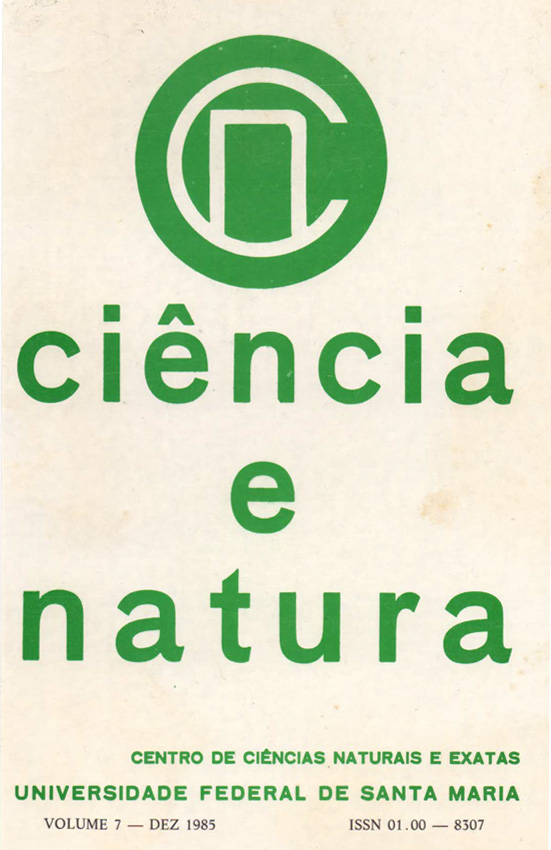Analytical standars and quantitative analysis of steviosides
DOI:
https://doi.org/10.5902/2179460X25406Abstract
It was established analytical parameters for steviosides standard, besides the obtainment and purification of theses paramters. The metodology for quantitative determination was proposed for the stevioside analysis in spectrofotometry U.V. The quantitative analysis by spectrofotometry was in 208nm, in ethilic alcool. The curve of calibration presented good relative precision, with analytical error 1.5%. The parameters established in caracterization of standars was: m.p: 197-200 ºC; Rf around of 0.58; maximum absorption in 208nm and molar absortivity higher 4000 in 208nm.
Downloads
References
ANGELUCCI, E. O esteviosídeo de plantas brasileiras de Stevia rebaudiana Bertoni e a potencialidade de seu emprego em alimentos. Ensaios em formulações hídricas e carbonatadas. São Paulo, Universidade de São Paulo, Curso de Pós-Graduação em Ciência dos Alimentos, 1979, 78f. Tese doutorado Ciência dos Alimentos.
AYRES, G.H. Analisis Químico Cuantitativo. Harper & Row Publishers Inc., Buenos Aires, 1968, p 486-490.
BRIDEL, M. & LAVIELLE, R. Sur le principe sucré des feuilles de Kaá-hê-é (Stevia rebaudiana Bertoni). Compt. Rend., Acad.Sci. Paris, 192: 1123-1125, 1931.
CHEN, W.S. & YEH, C.S. Preliminary report on the examination of stevioside by high - pressure liquid chromatography. Tái-Wan T'ang Yeh Yen so Yen Chiu Hui Pao. Taiwan, 79:43-48,1978.
GATONI, L. et alii. Una planta silvestre nativa del Paraguay (Stevia rebaudiana Bert.) Instituto Agronômico Nacional del STICA. Assuncion, Paraguay. Setiembre de 1945. 5p. (datilogrado).
HASHIMOTO, Y. et alii. High - performance liquid chromatographic
determination of Stevia components on a hydrophilic packed column. J.Chromatog., Amsterdam, 161: 403-405, 1978.
HODGES, J.E. & UNGLETT, G.E. Structural Aspects of Glisocidic Sweeteners containing (1 '2) - Linked Disaccharides. In: INGLETT, G.E. Symposium Sweeteners. The Avi Publishing Company. Inc. Connecticut, p 216-234, 1974.
KHODA, H. et alii. New swet dipertene glucosides from Stevia rebaudiana. Phytochemistry, Oxford, 15: p. 81-983, 1976.
MITSUHASHI, H.; UENO, J. & SUMITAT, T. Studies on cultivation of Stevia rebaudiana Bertoni. Determination of stevioside. Yakugaku Zasshi, Tokio, 95(1): 127-130, 1975.
_____________ Studies on the cultivation of Stevia rebaudiana Bertoni. Determination of stevioside II. Yakugaku Zasshi, Tokio , 95(12): 1501-1503, 1975.
RASENACK, P. Uber die susstoffe des Eupatorium rebaudianum um des süssholzes Arb. Kaiser. Gesundh, Deutscb lend , 28: 420-443,1908.
REBAUDIO, O. Nota sobre el Káa-hê-é. Rev.Quim.Farm., Buenos Aires, 2, 3, 4, 1980.
SAKAGUCHI, M. & KANT, T. As pesquisas japonesas com Stevia rebaudiana (Bert) Bertoni e o esteviosídeo, Ciênaia e Cultura, 34 (2): 235-248, 1982.
SAKAMOTO, I. et alii. Quantitative analysis of stevioside. Yakugaku Zasshi, Tokio, 95 (12): 1507-1510, 1975.
SUGISAWA, H.; KASAI, T. & SUSZI, H. The modified quantitative analysis of stevioside. Nippon Nogri Kagaku Kaishi, Tokio, 51(3):175-177, 1977.
WOOD, J.R. et alii. Stevioside III. The anomeric 2,3,4,6 - tetra-o-acetyl-l-o-mesitoyl-o-glucopyranoses and their behavior with alkali. J.Am.Chem.Soc., Philadelphia, 78: 207-210, 1956.
Downloads
Published
How to Cite
Issue
Section
License
To access the DECLARATION AND TRANSFER OF COPYRIGHT AUTHOR’S DECLARATION AND COPYRIGHT LICENSE click here.
Ethical Guidelines for Journal Publication
The Ciência e Natura journal is committed to ensuring ethics in publication and quality of articles.
Conformance to standards of ethical behavior is therefore expected of all parties involved: Authors, Editors, Reviewers, and the Publisher.
In particular,
Authors: Authors should present an objective discussion of the significance of research work as well as sufficient detail and references to permit others to replicate the experiments. Fraudulent or knowingly inaccurate statements constitute unethical behavior and are unacceptable. Review Articles should also be objective, comprehensive, and accurate accounts of the state of the art. The Authors should ensure that their work is entirely original works, and if the work and/or words of others have been used, this has been appropriately acknowledged. Plagiarism in all its forms constitutes unethical publishing behavior and is unacceptable. Submitting the same manuscript to more than one journal concurrently constitutes unethical publishing behavior and is unacceptable. Authors should not submit articles describing essentially the same research to more than one journal. The corresponding Author should ensure that there is a full consensus of all Co-authors in approving the final version of the paper and its submission for publication.
Editors: Editors should evaluate manuscripts exclusively on the basis of their academic merit. An Editor must not use unpublished information in the editor's own research without the express written consent of the Author. Editors should take reasonable responsive measures when ethical complaints have been presented concerning a submitted manuscript or published paper.
Reviewers: Any manuscripts received for review must be treated as confidential documents. Privileged information or ideas obtained through peer review must be kept confidential and not used for personal advantage. Reviewers should be conducted objectively, and observations should be formulated clearly with supporting arguments, so that Authors can use them for improving the paper. Any selected Reviewer who feels unqualified to review the research reported in a manuscript or knows that its prompt review will be impossible should notify the Editor and excuse himself from the review process. Reviewers should not consider manuscripts in which they have conflicts of interest resulting from competitive, collaborative, or other relationships or connections with any of the authors, companies, or institutions connected to the papers.






